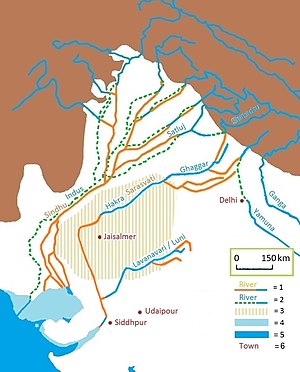Dangri
| Dangri river Tangri river | |
|---|---|
 Ghaggar-Hakra Sarasvati rivers and tributaries | |
| Location | |
| Country | India |
| Physical characteristics | |
| Source | |
| • location | Shivalik Hills, Himachal Pradesh |
| Length | 70 km (43 mi) |
| Discharge | |
| • location | Ghaggar river in Haryana |
| Basin features | |
| Tributaries | |
| • right | Balaiali river, Amri river (Dadri river or Shahzadpur Wali river) |
The Tangri River, also called the Dangri River, which originates in the Shivalik Hills, is a tributary of the Ghaggar River in the Haryana state of India.[1][2]
Origin and route
The Tangri river originates in the Shivalik hills on the border of Haryana and Himachal Pradesh State, and flows along the Haryana and Punjab border before meeting with the Ghaggar river at the confluence.[3] The basin is classified in two parts, Khadir and Bangar, the higher area that is not flooded in rainy season is called Bangar and the lower flood-prone area is called Khadar.[3]
The Dangri or Tangri is a stream that rises in the Morni Hills of the Siwalik Hills of south-eastern Himachal Pradesh in India,[4] and flows for 70 km in Haryana.[5] It confluences with the Markanda River (Haryana) at the Haryana-Punjab border north of Sadhpur Viran in the northwest of the Kurukshetra district and south of Mehmudpur Rurki in south Patiala district. The combined Dangir-Markanda stream merges with the Sarsuti River in northeast Kaithal district, east of Diwana and southwest of Adoya, before joining the Ghaggar river just east of Dhando village near Kasoli town in northwest Kaithal.[4] It is thereafter known as the Ghaggar. Further downstream on the banks of the Ghaggar stands an old derelict fort at Sirsa town named Sarsuti.[4] After the Ottu barrage, the Ghaggar river is called the Hakra River and in Sindh it is called the Nara River. The order of rivers from left to right is the Ghaggar, Dangri, Markanda and Sarsuti. Further left to the right, the Chautang and Somb rivers are tributaries of the Yamuna.
It is believed that Sarsuti is a corruption of the word Sarasvati and that the 6–8 km wide channel of the Sarsuti–Ghaggar system might have once been the Sarasvati River mentioned in the Rig Veda.[4][6] This Sarsuti channel is currently being revived by the Government of Haryana as the ancient Sarasvat river.
Tributaries
Originating from the Morni Hills, the Tangri confluences with its southern tributary called the Balaiali River (which originates near the south of the Morni Hills) near Chajju Majra, south of Kharar. Near Panjokhra, southeast of Ambala, the Tangri River divides into two streams that flow north and south of Ambala. Further downstream near Segti and Segta villages, the Tangri River confluences with its tributary called the Amri River (also known as the Dadri River and the Shahzadpur Wali River, which originates near Rataur)) after Amri has already collected its own tributary called the Omla River.[7]
- Ghaggar, 250 km[5]
- Kaushalya river, 20 km,[5] tributary of the Ghaggar which confluences in Panchkula
- Markanda river, 90 km,[5] eastern tributary of the Ghaggar
- Dangri river (Tangri), 70 km,[5] western tributary of the Ghaggar
- Balaiali river, eastern tributary of the Dangri
- Amri river (Dadri River or Shahzadpur Wali river), eastern tributary of the Dangri
- Omla river, tributary of the Amri river
- Numerous other streams in Yamunanagar district
- Dangri river (Tangri), 70 km,[5] western tributary of the Ghaggar
- Sarsuti, ? km,[5] eastern tributary of the Ghaggar
- Chautang, 9 km,[5] eastern tributary of the Ghaggar
Several archaeologists have identified the old Ghaggar-Hakra River with the Sarasvati river, on the banks of which the Indus Valley Civilisation developed.[8][9][10][11]
Gallery
-
Indus-Sarasvati civilisation major sites
See also
References
- ^ AmbalaOnline - Rivers in Ambala
- ^ Chopra, Sanjeev (25 September 2010). "Overflowing Ghaggar, Tangri inundate some villages along Punjab-Haryana border". The Indian Express. Retrieved 9 April 2017.
- ^ a b "HaryanaOnline - Geography of Haryana". Archived from the original on 1 February 2016. Retrieved 14 February 2018.
- ^ a b c d Valdiya, K.S. (2002). Saraswati : the river that disappeared. Hyderabad: Orient Longman. pp. 23–27. ISBN 9788173714030. Retrieved 4 May 2015.
- ^ a b c d e f g Haryana rivers profile, South Asia Network on Dams, Rivers and People.
- ^ Danino, Michel (2010). The lost river : on the trail of the Sarasvatī. New Delhi: Penguin Books India. p. 12. ISBN 9780143068648. Retrieved 4 May 2015. (Chapter 1, page 12)
- ^ Rivers in Ambala
- ^ Possehl, Gregory L. (December 1997), "The Transformation of the Indus Civilization", Journal of World Prehistory, 11 (4): 425–472, doi:10.1007/bf02220556, JSTOR 25801118, S2CID 161129625
- ^ Kenoyer, J. M. (1997), "Early City-states in South Asia: Comparing the Harappan Phase and the Early Historic Period", in D. L. Nichols; T. H. Charlton (eds.), The Archaeology of City States: Cross Cultural Approaches, Washington: Smithsonian Institution Press, pp. 52–70, ISBN 1560987227
- ^ Allchin, Bridget; Allchin, Raymond (1982), The Rise of Civilization in India and Pakistan, Cambridge University Press, p. 160, ISBN 978-0-521-28550-6
- ^ Erdosy 1995, p. 44, 266.


